

Compact Muon Solenoid
LHC, CERN
| CMS-EXO-21-005 ; CERN-EP-2023-165 | ||
| Search for direct production of GeV-scale resonances decaying to a pair of muons in proton-proton collisions at $ \sqrt{s} = $ 13 TeV | ||
| CMS Collaboration | ||
| 28 September 2023 | ||
| JHEP 12 (2023) 070 | ||
| Abstract: A search for direct production of low-mass dimuon resonances is performed using $ \sqrt{s}= $ 13 TeV proton-proton collision data collected by the CMS experiment during the 2017-2018 operation of the CERN LHC with an integrated luminosity of 96.6 fb$^{-1}$. The search exploits a dedicated high-rate trigger stream that records events with two muons with transverse momenta as low as 3 GeV but does not include the full event information. The search is performed by looking for narrow peaks in the dimuon mass spectrum in the ranges of 1.1-2.6 GeV and 4.2-7.9 GeV. No significant excess of events above the expectation from the standard model background is observed. Model-independent limits on production rates of dimuon resonances within the experimental fiducial acceptance are set. Competitive or world's best limits are set at 90% confidence level for a minimal dark photon model and for a scenario with two Higgs doublets and an extra complex scalar singlet (2HDM+S). Values of the squared kinetic mixing coefficient $ \varepsilon^2 $ in the dark photon model above 10$^{-6} $ are excluded over most of the mass range of the search. In the 2HDM+S, values of the mixing angle $ \sin(\theta_{\mathrm{H}}) $ above 0.08 are excluded over most of the mass range of the search with a fixed ratio of the Higgs doublets vacuum expectation $ \tan\beta= $ 0.5. | ||
| Links: e-print arXiv:2309.16003 [hep-ex] (PDF) ; CDS record ; inSPIRE record ; HepData record ; Physics Briefing ; CADI line (restricted) ; | ||
| Figures & Tables | Summary | Additional Figures & Tables | References | CMS Publications |
|---|
| Figures | |

png pdf |
Figure 1:
Expected dominant production modes for a dark photon $ \mathrm{Z}_{\mathrm{D}} $ (left) and light beyond-SM pseudoscalar boson $\mathrm{a}$ (right). |
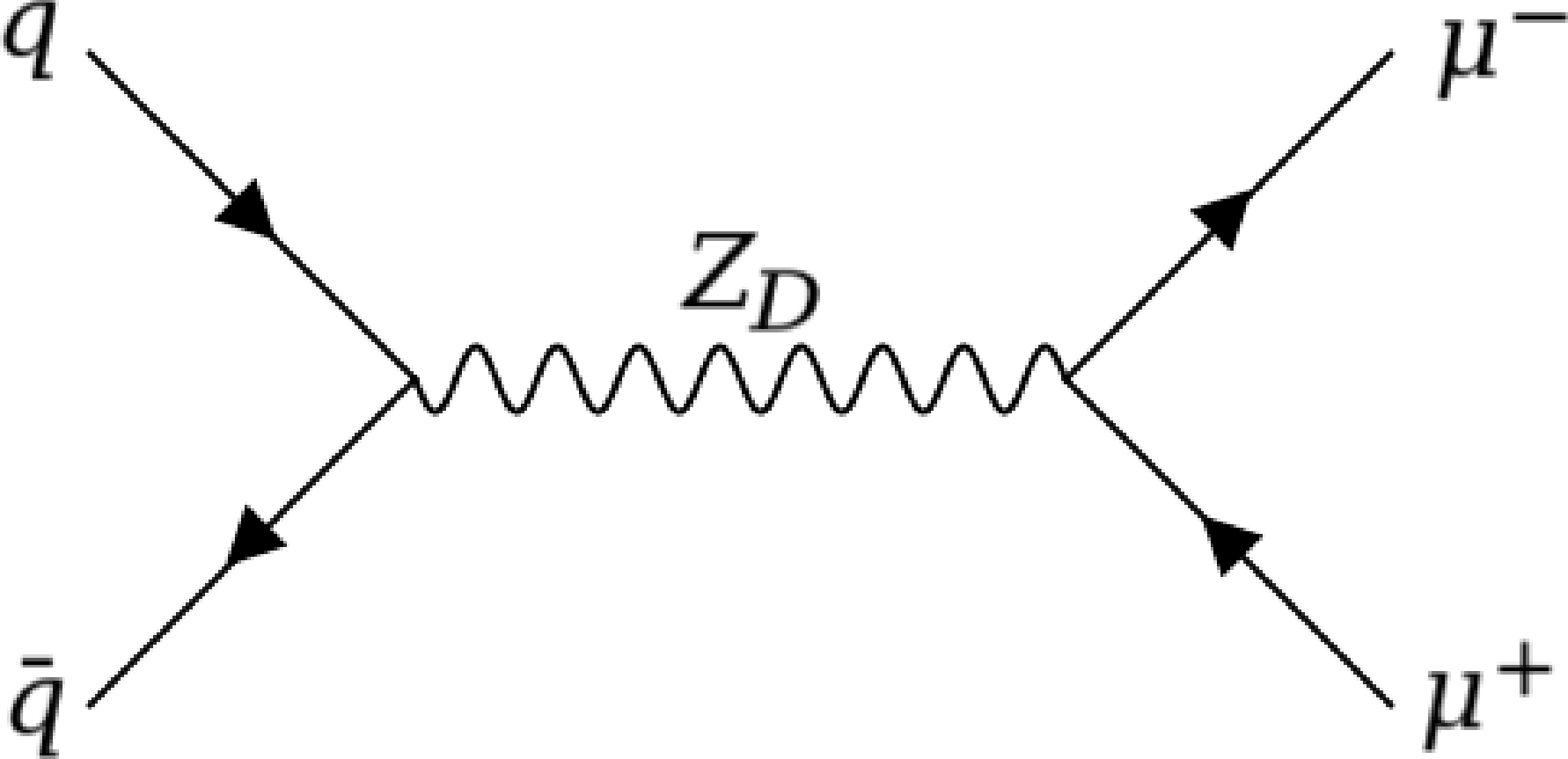
png pdf |
Figure 1-a:
Expected dominant production mode for a dark photon $ \mathrm{Z}_{\mathrm{D}} $. |
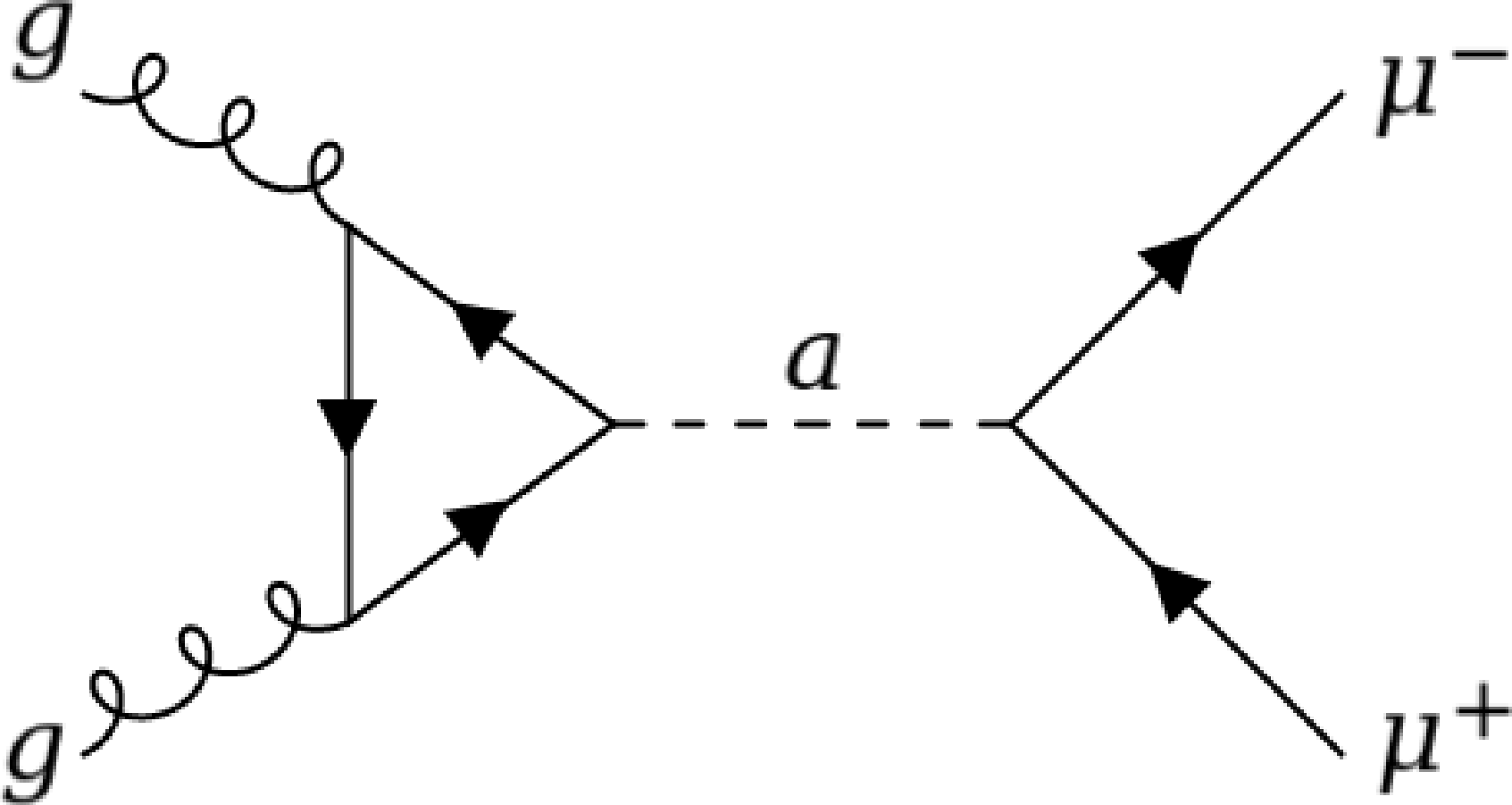
png pdf |
Figure 1-b:
Expected dominant production mode for a light beyond-SM pseudoscalar boson $\mathrm{a}$. |

png pdf |
Figure 2:
The measured 2017 (left) and 2018 (right) efficiencies of the dimuon scouting trigger and logical OR of all L1 triggers using 2017-2018 data. Each cell value represents the probability that a pair of muons meeting the trigger requirements will activate the dimuon scouting trigger. The $ x $-axis shows the dimuon mass and includes the entire relevant range for this analysis. The $ y $-axis shows the angular separation, $ \Delta R $, between the two muons. Statistical uncertainty on the value of each cell is less than 5%. |
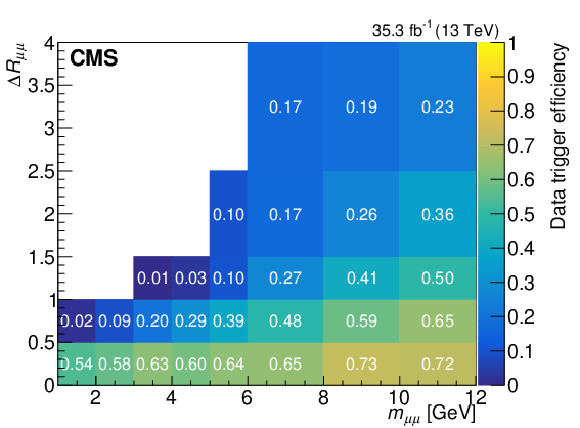
png pdf |
Figure 2-a:
The measured 2017 efficiency of the dimuon scouting trigger and logical OR of all L1 triggers using 2017-2018 data. Each cell value represents the probability that a pair of muons meeting the trigger requirements will activate the dimuon scouting trigger. The $ x $-axis shows the dimuon mass and includes the entire relevant range for this analysis. The $ y $-axis shows the angular separation, $ \Delta R $, between the two muons. Statistical uncertainty on the value of each cell is less than 5%. |
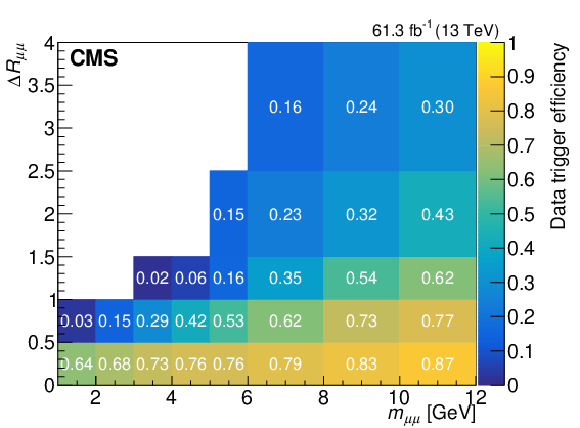
png pdf |
Figure 2-b:
The measured 2018 efficiency of the dimuon scouting trigger and logical OR of all L1 triggers using 2017-2018 data. Each cell value represents the probability that a pair of muons meeting the trigger requirements will activate the dimuon scouting trigger. The $ x $-axis shows the dimuon mass and includes the entire relevant range for this analysis. The $ y $-axis shows the angular separation, $ \Delta R $, between the two muons. Statistical uncertainty on the value of each cell is less than 5%. |
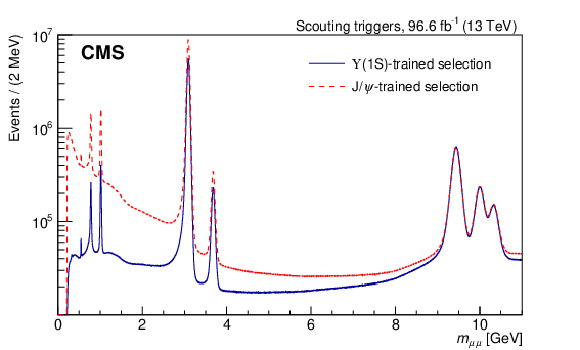
png pdf |
Figure 3:
The $ m_{\mu\mu} $ distribution obtained with the muon scouting data collected during 2017-2018 with two sets of selections: the $ \Upsilon{\textrm{(1S)}} $-trained muon MVA identification with $ L_{\mathrm{xy}} < $ 0.015 cm (blue, solid), and the J$/ \psi $-trained muon MVA identification with $ L_{\mathrm{xy}}/{\sigma}_{L_{\mathrm{xy}}} < $ 3.5 (red, dashed). |
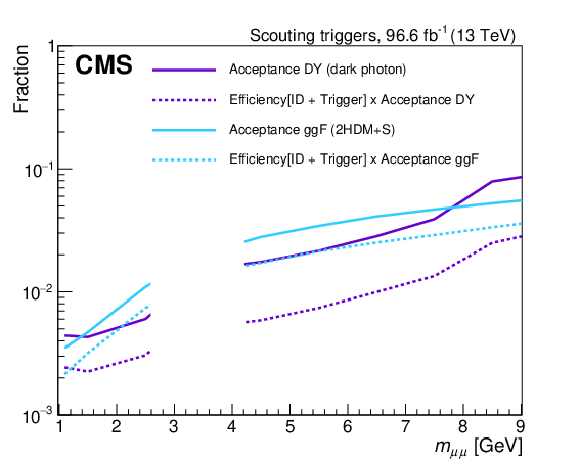
png pdf |
Figure 4:
The signal acceptance and reconstruction efficiency are extracted from the dark photon (purple, dark) and pseudoscalar (cyan, light) simulations. The region at 2.6-4.2 GeV is excluded because of the presence of the J$/ \psi $ and $ \psi $(2S) resonances. |

png pdf |
Figure 5:
Left: Expected and observed model-independent upper limits at 95% CL on the product of the signal cross section ($ \sigma $), the branching fraction to a pair of muons for the inclusive dimuon selection ($ \mathcal{B} $), and fiducial acceptance ($ A $). Right: The model-independent limits for the high-$ p_{\mathrm{T}} $ selection. The mass region dominated by the J$/ \psi $ and $ \psi $(2S) resonances is excluded from the search. |
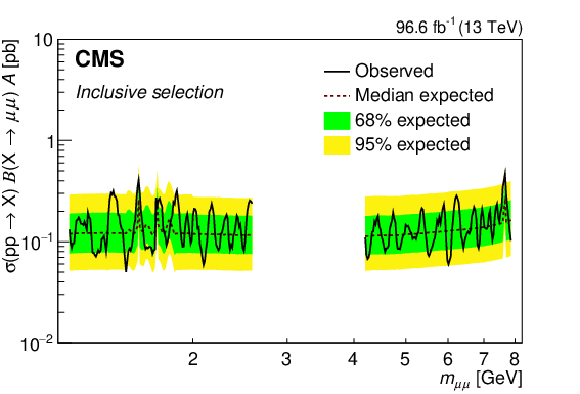
png pdf |
Figure 5-a:
Expected and observed model-independent upper limits at 95% CL on the product of the signal cross section ($ \sigma $), the branching fraction to a pair of muons for the inclusive dimuon selection ($ \mathcal{B} $), and fiducial acceptance ($ A $). |
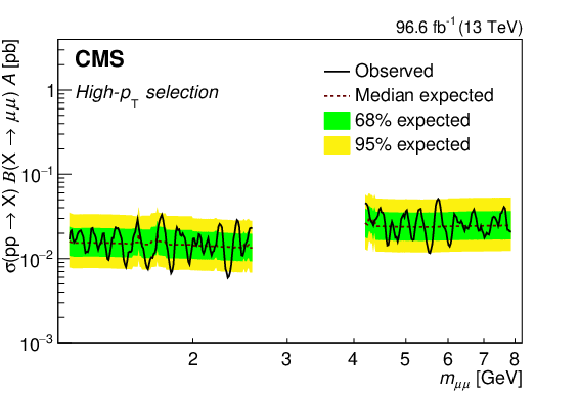
png pdf |
Figure 5-b:
The model-independent limits for the high-$ p_{\mathrm{T}} $ selection. The mass region dominated by the J$/ \psi $ and $ \psi $(2S) resonances is excluded from the search. |

png pdf |
Figure 6:
Observed upper limits at 90% CL on the square of the kinetic mixing coefficient $ \varepsilon $ in the minimal model of a dark photon from the CMS search in the mass ranges of 1.1-2.6 GeV and 4.2-7.9 GeV (pink). The CMS limits are compared with the existing limits at 90% CL provided by LHCb [13] (blue) and BaBar [11] (gray). |
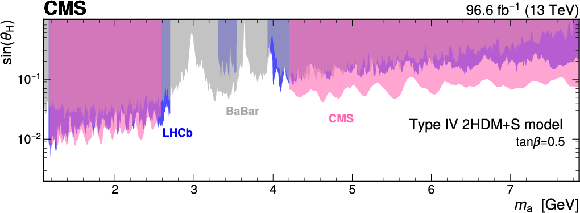
png pdf |
Figure 7:
Observed upper limits at 90% CL on the mixing angle $ \theta_{\mathrm{H}} $ for the 2HDM+S scenario from the CMS search in the mass ranges of 1.1-2.6 GeV and 4.2-7.9 GeV (pink). The CMS limits are compared with the existing limits at 90% CL provided by LHCb [20] (blue) and BaBar [11] (gray). |
| Tables | |

png pdf |
Table 1:
The set of dimuon L1 requirements applied in the high-rate triggers. |

png pdf |
Table 2:
Summary of all selection criteria for an event to enter the analysis in inclusive and high-$ p_{\mathrm{T}} $ search categories. |

png pdf |
Table 3:
Summary of the experimental systematic uncertainties for a signal model in the model independent search for a dimuon resonance. |
| Summary |
| A search for direct production of a narrow resonance decaying to a pair of muons has been presented using proton-proton collision data recorded by the CMS experiment at $ \sqrt{s}= $ 13 TeV in 2017-2018. The search is performed in the dimuon mass regions of 1.1-2.6 GeV and 4.2-7.9 GeV using data collected in a dedicated high-rate trigger stream, corresponding to an integrated luminosity of 96.6 fb$ ^{-1} $. A multivariate analysis method is used to identify muons to achieve a higher sensitivity. No significant excess of events above the expectation from the standard model background is observed. Model-independent limits on production rates of dimuon resonances within the experimental fiducial acceptance are set. Competitive or world's best limits are set at 90% confidence level for a minimal dark photon model and for a scenario with two Higgs doublets and an extra complex scalar singlet (2HDM+S). Values of the squared kinetic mixing coefficient $ \varepsilon^2 $ in the dark photon model above 10$^{-6} $ are excluded over most of the mass range of the search. In the 2HDM+S, values of the mixing angle $ \sin(\theta_{\mathrm{H}}) $ above 0.08 are excluded over most of the mass range of the search with a fixed ratio of the Higgs doublets vacuum expectation $ \tan\beta= $ 0.5. |
| Additional Figures | |
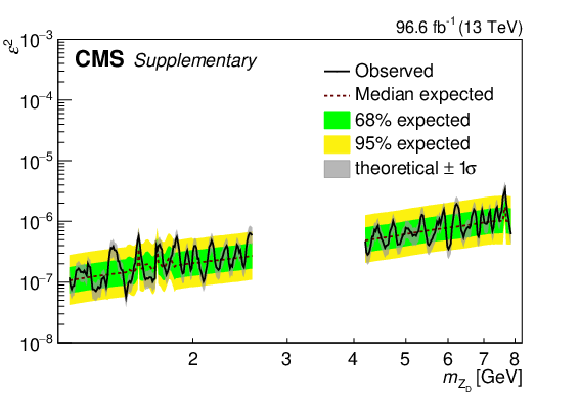
png pdf |
Additional Figure 1:
Upper limits at 90% CL on the square of the kinetic mixing coefficient $ \varepsilon $ in the minimal model of a dark photon from the CMS search in the mass ranges of 1.1-2.6 GeV and 4.2-7.9 GeV using 2017 and 2018 scouting data which corresponds to an integrated luminosity of 96.6 fb$ ^{-1} $. The theoretical uncertainty includes the variation of QCD scales when calculating the production cross section, as well as the variance in fiducial acceptance between dark photon signal events produced using two different generators; DYTURBO and MADGRAPH 5_aMC@NLO v3.4.1. |

png pdf |
Additional Figure 2:
Upper limits at 90% CL on the mixing angle $ \theta_{\rm H} $ for the 2HDM+S scenario the CMS search in the mass ranges of 1.1-2.6 GeV and 4.2-7.9 GeV using 2017 and 2018 scouting data which corresponds to an integrated luminosity of 96.6 fb$ ^{-1} $. The theoretical uncertainty includes the variation of QCD scales when calculating the production cross section, as well as the variance in fiducial acceptance between scalar signal events produced using two different generators; PYTHIA 8.230 and MADGRAPH 5_aMC@NLO v3.4.1. |
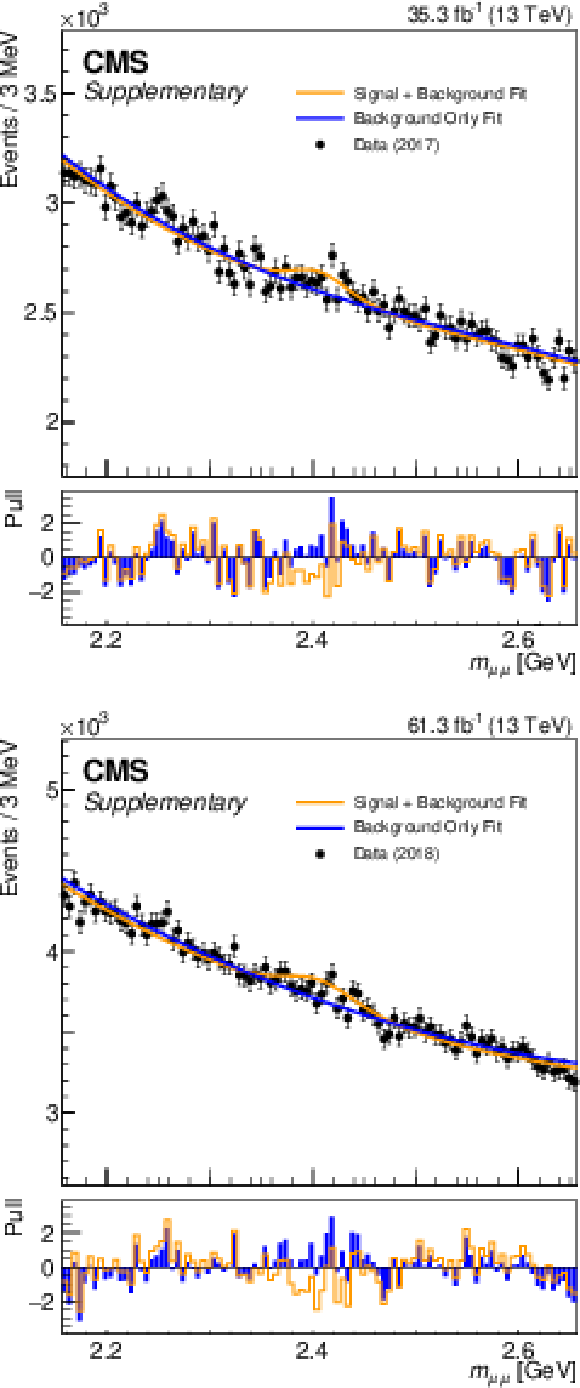
png pdf |
Additional Figure 3:
Background only and signal plus background fits, for the mass window 2.25-2.56 GeV with 2.58$ \sigma $ excess in 2017 (top) and 2018 (bottom). This excess is observed only in the mass distribution with the dimuon high-$ p_{\mathrm{T}} $ selection and therefore only affects the limit on the scalar model. The lower pads show the difference between the data and corresponding pdf, divided by the statistical uncertainty of the data in that bin. |
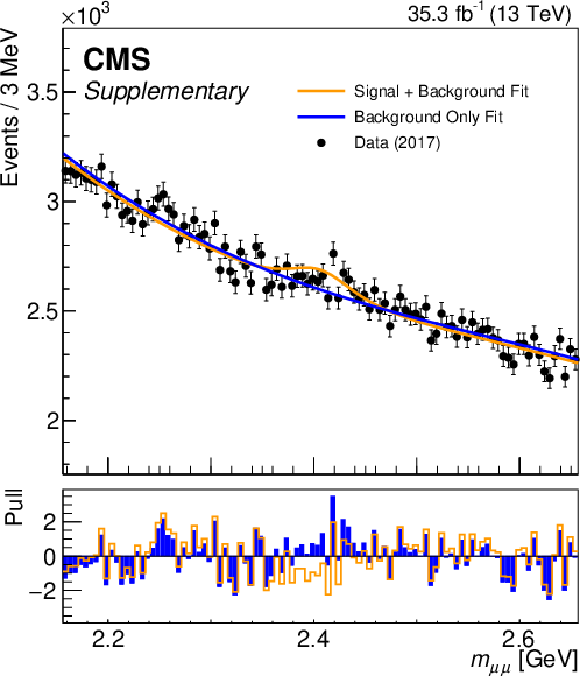
png pdf |
Additional Figure 3-a:
Background only and signal plus background fits, for the mass window 2.25-2.56 GeV in 2017. The lower pad shows the difference between the data and corresponding pdf, divided by the statistical uncertainty of the data in that bin. |
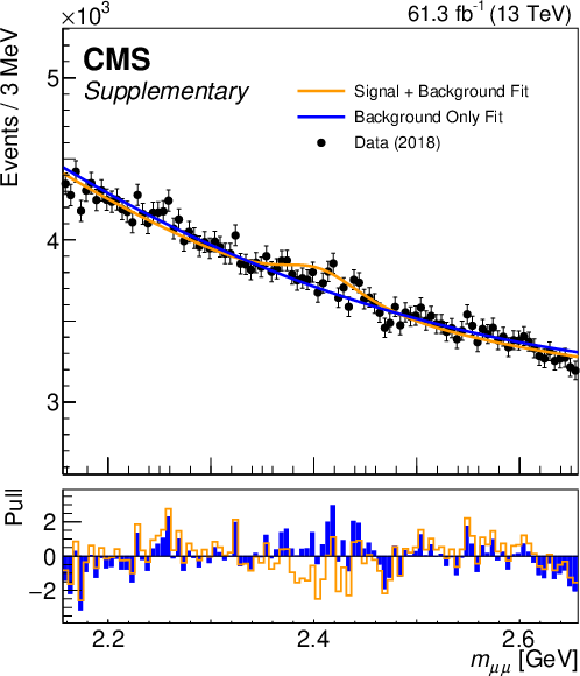
png pdf |
Additional Figure 3-b:
Background only and signal plus background fits, for the mass window 2.25-2.56 GeV in 2018. The lower pad shows the difference between the data and corresponding pdf, divided by the statistical uncertainty of the data in that bin. |
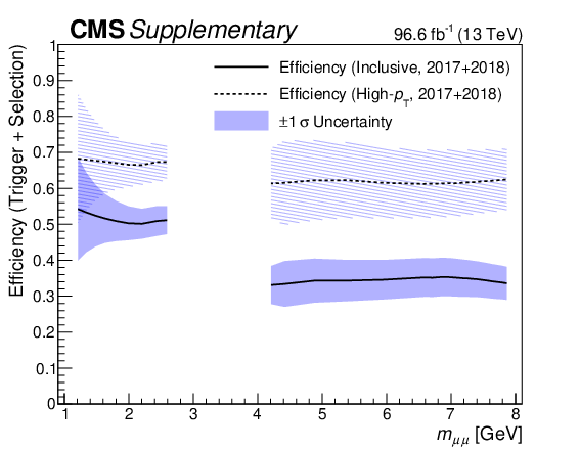
png pdf |
Additional Figure 4:
The combined efficiency of the dimuon scouting trigger and the MVA muon selection, averaged between 2017 and 2018, weighted by the integrated luminosity of each year. The solid line shows the efficiency of the inclusive selection used for the limit on the dark photon model. The dashed line shows the efficiency of the high-$ p_{\mathrm{T}} $ selection optimized for the scalar model. |
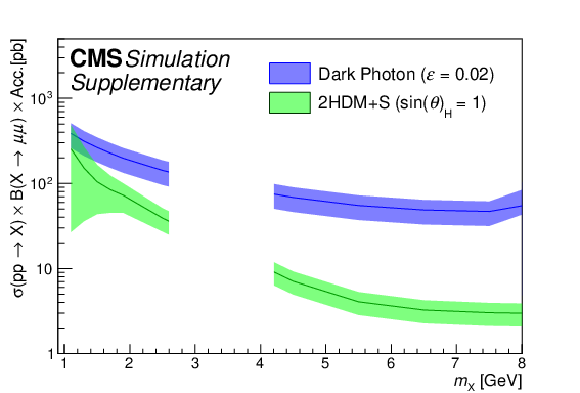
png pdf |
Additional Figure 5:
Theory cross-section times branching fraction to muons times acceptance for the dark photon and 2HDM+S models. The dark photon theory cross section is calculated using MADGRAPH 5_aMC@NLO v3.4.1 assuming $ \varepsilon = $ 0.02, and the acceptance is derived using DYTURBO. The 2HDM+S model theory cross section is calculated using HIGLU at NNLO assuming $ \sin(\theta_{\rm H}) = $ 1, and the acceptance is derived from PYTHIA 8.230. |
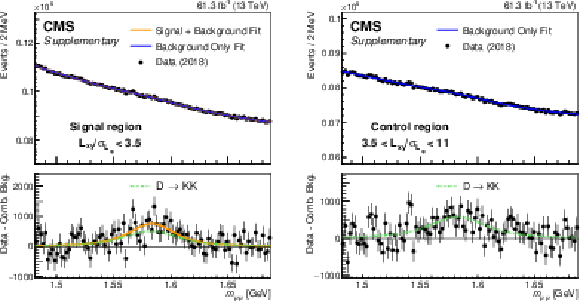
png pdf |
Additional Figure 6:
The contribution of $ \mathrm{D^0}\to \mathrm{K^+}\mathrm{K^-} $ in the simultaneous fit in signal region (left) and control regions (right) in 2018 data for the inclusive dimuon selection. The background contains non-peaking combinatorial background and $ \mathrm{D^0}\to \mathrm{K^+}\mathrm{K^-} $ background. In the bottom panel, the combinatorial background component in the signal plus background fit is subtracted from the observed data (``Data - Comb. Bkg.''). |
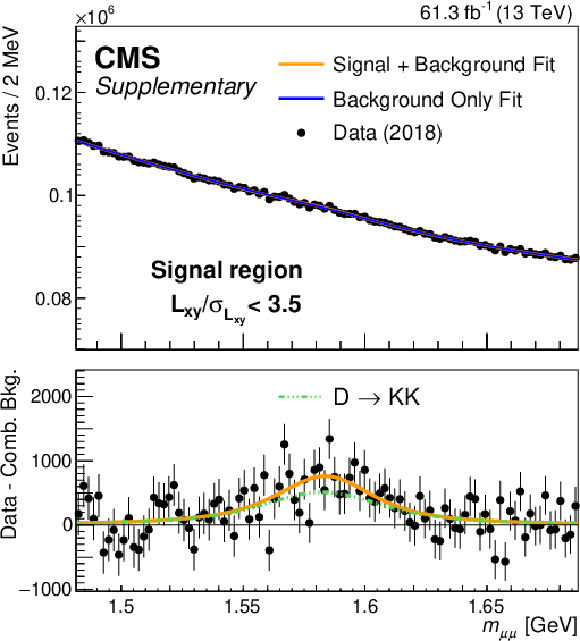
png pdf |
Additional Figure 6-a:
The contribution of $ \mathrm{D^0}\to \mathrm{K^+}\mathrm{K^-} $ in the simultaneous fit in the signal region in 2018 data for the inclusive dimuon selection. The background contains non-peaking combinatorial background and $ \mathrm{D^0}\to \mathrm{K^+}\mathrm{K^-} $ background. In the bottom panel, the combinatorial background component in the signal plus background fit is subtracted from the observed data (``Data - Comb. Bkg.''). |
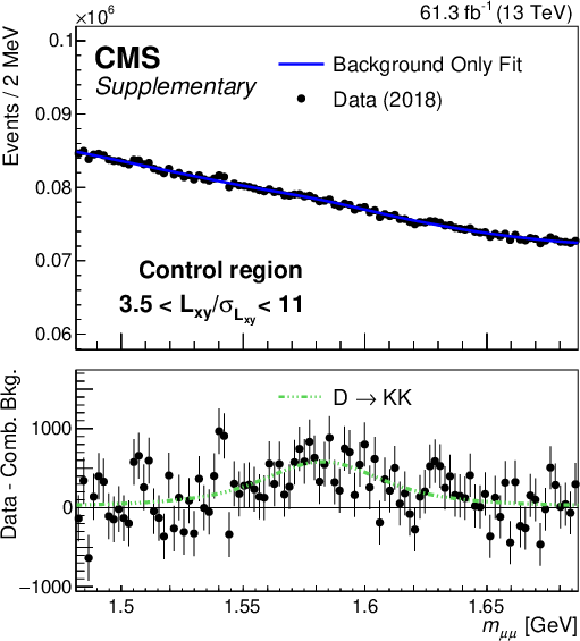
png pdf |
Additional Figure 6-b:
The contribution of $ \mathrm{D^0}\to \mathrm{K^+}\mathrm{K^-} $ in the simultaneous fit in the control region in 2018 data for the inclusive dimuon selection. The background contains non-peaking combinatorial background and $ \mathrm{D^0}\to \mathrm{K^+}\mathrm{K^-} $ background. In the bottom panel, the combinatorial background component in the signal plus background fit is subtracted from the observed data (``Data - Comb. Bkg.''). |
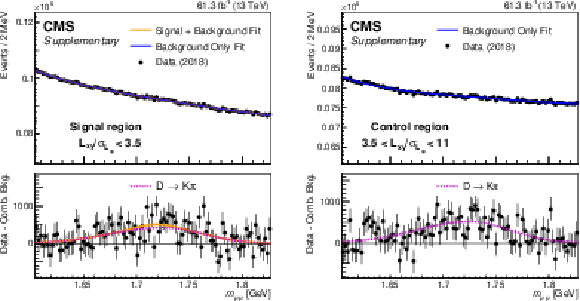
png pdf |
Additional Figure 7:
The contribution of $ \mathrm{D^0}\to\mathrm{K^-}\pi^{+} $ in the simultaneous fit in signal region (left) and control regions (right) in 2018 data for the inclusive dimuon selection. The background contains non-peaking combinatorial background and $ \mathrm{D^0}\to\mathrm{K^-}\pi^{+} $ background. In the bottom panel, the combinatorial background component in the signal plus background fit is subtracted from the observed data (``Data - Comb. Bkg.''). |

png pdf |
Additional Figure 7-a:
The contribution of $ \mathrm{D^0}\to\mathrm{K^-}\pi^{+} $ in the simultaneous fit in the signal region in 2018 data for the inclusive dimuon selection. The background contains non-peaking combinatorial background and $ \mathrm{D^0}\to\mathrm{K^-}\pi^{+} $ background. In the bottom panel, the combinatorial background component in the signal plus background fit is subtracted from the observed data (``Data - Comb. Bkg.''). |
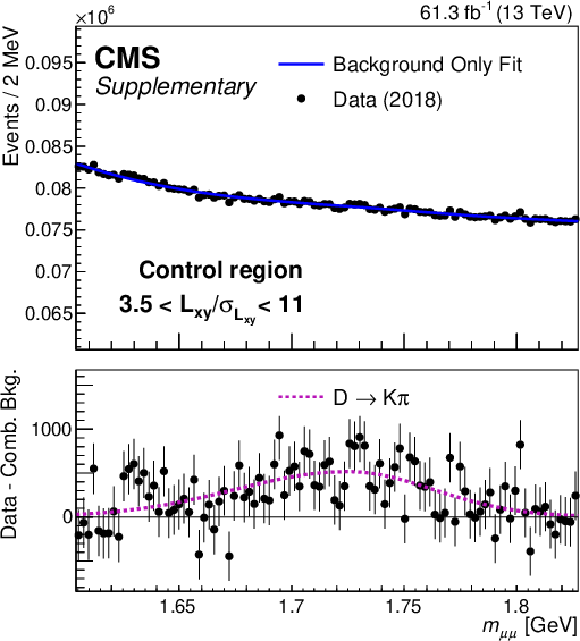
png pdf |
Additional Figure 7-b:
The contribution of $ \mathrm{D^0}\to\mathrm{K^-}\pi^{+} $ in the simultaneous fit in the control region in 2018 data for the inclusive dimuon selection. The background contains non-peaking combinatorial background and $ \mathrm{D^0}\to\mathrm{K^-}\pi^{+} $ background. In the bottom panel, the combinatorial background component in the signal plus background fit is subtracted from the observed data (``Data - Comb. Bkg.''). |

png pdf |
Additional Figure 8:
The observed local p-value for the inclusive dimuon selection (left) and high-$ p_{\mathrm{T}} $ selection (right). The mass region dominated by the J$/ \psi $ and $\psi$(2S) resonances is excluded from the search. |

png pdf |
Additional Figure 8-a:
The observed local p-value for the inclusive dimuon selection. The mass region dominated by the J$/ \psi $ and $\psi$(2S) resonances is excluded from the search. |
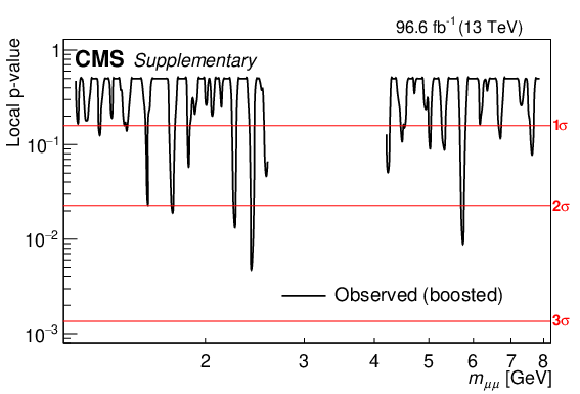
png pdf |
Additional Figure 8-b:
The observed local p-value for the high-$ p_{\mathrm{T}} $ selection. The mass region dominated by the J$/ \psi $ and $\psi$(2S) resonances is excluded from the search. |
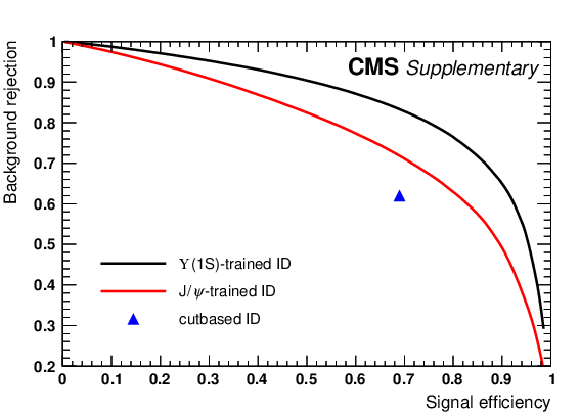
png pdf |
Additional Figure 9:
The ROC curves of J/$ \psi $-trained and $ \Upsilon $-trained muon MVA identification in comparison to the cut-based identification used in the previous CMS dark photon search. |
| Additional Tables | |

png pdf |
Additional Table 1:
The fiducial space for the signal acceptance. |
| References | ||||
| 1 | J. J. Aubert et al. | Experimental observation of a heavy particle $ J $ | PRL 33 (1974) 1404 | |
| 2 | J. E. Augustin et al. | Discovery of a narrow resonance in $ \text{e}^{+}\text{e}^{-} $ annihilation | PRL 33 (1974) 1406 | |
| 3 | S. W. Herb et al. | Observation of a dimuon resonance at 9.5 GeV in 400-GeV proton-nucleus collisions | PRL 39 (1977) 252 | |
| 4 | UA1 Collaboration | Experimental observation of lepton pairs of invariant mass around 95 GeV/c$ ^2 $ at the CERN SPS collider | PLB 126 (1983) 398 | |
| 5 | ATLAS Collaboration | Observation of a new particle in the search for the Standard Model Higgs boson with the ATLAS detector at the LHC | PLB 716 (2012) 1 | 1207.7214 |
| 6 | CMS Collaboration | Observation of a new boson at a mass of 125 GeV with the CMS experiment at the LHC | PLB 716 (2012) 30 | CMS-HIG-12-028 1207.7235 |
| 7 | CMS Collaboration | Observation of a new boson with mass near 125 GeV in pp collisions at $ \sqrt{s}= $ 7 and 8 TeV | JHEP 06 (2013) 81 | CMS-HIG-12-036 1303.4571 |
| 8 | ATLAS Collaboration | Search for high-mass dilepton resonances using 139 fb$ ^{-1} $ of pp collision data collected at $ \sqrt{s} = $ 13 TeV with the ATLAS detector | PLB 796 (2019) 68 | 1903.06248 |
| 9 | CMS Collaboration | Search for resonant and nonresonant new phenomena in high-mass dilepton final states at $ \sqrt{s} = $ 13 TeV | JHEP 07 (2021) 208 | CMS-EXO-19-019 2103.02708 |
| 10 | N. Arkani-Hamed, D. P. Finkbeiner, T. R. Slatyer, and N. Weiner | A theory of dark matter | PRD 79 (2009) 015014 | 0810.0713 |
| 11 | BaBar Collaboration | Search for a dark photon in $ \text{e}^+\text{e}^- $ collisions at BaBar | PRL 113 (2014) 201801 | 1406.2980 |
| 12 | LHCb Collaboration | Search for dark photons produced in 13 TeV pp collisions | PRL 120 (2018) 061801 | 1710.02867 |
| 13 | LHCb Collaboration | Search for $ A'\to\mu^+\mu^- $ decays | PRL 124 (2020) 041801 | 1910.06926 |
| 14 | LHCb Collaboration | Searches for low-mass dimuon resonances | JHEP 10 (2020) 156 | 2007.03923 |
| 15 | CMS Collaboration | Search for a narrow resonance lighter than 200 GeV decaying to a pair of muons in proton-proton collisions at $ \sqrt{s} = $ 13 TeV | PRL 124 (2020) 131802 | CMS-EXO-19-018 1912.04776 |
| 16 | CMS Collaboration | Search for narrow resonances in dijet final states at $ \sqrt{s} = $ 8 TeV with the novel CMS technique of data scouting | PRL 117 (2016) 031802 | CMS-EXO-14-005 1604.08907 |
| 17 | P. Galison and A. Manohar | Two Z's or not two Z's? | PLB 136 (1984) 279 | |
| 18 | B. Holdom | Two U(1)'s and $ \epsilon $ charge shifts | PLB 166 (1986) 196 | |
| 19 | D. Curtin, R. Essig, S. Gori, and J. Shelton | Illuminating dark photons with high-energy colliders | JHEP 02 (2015) 157 | 1412.0018 |
| 20 | U. Haisch, J. F. Kamenik, A. Malinauskas, and M. Spira | Collider constraints on light pseudoscalars | JHEP 03 (2018) 178 | 1802.02156 |
| 21 | S. Argyropoulos and U. Haisch | Benchmarking LHC searches for light 2HDM+a pseudoscalars | no.~1, 007, 2022 SciPost Phys. 13 (2022) |
2202.12631 |
| 22 | CMS Collaboration | HEPData record for this analysis | link | |
| 23 | CMS Collaboration | The CMS experiment at the CERN LHC | JINST 3 (2008) S08004 | |
| 24 | CMS Collaboration | The CMS trigger system | JINST 12 (2017) P01020 | CMS-TRG-12-001 1609.02366 |
| 25 | CMS Collaboration | Search for dijet resonances in proton-proton collisions at $ \sqrt{s} = $ 13 TeV and constraints on dark matter and other models | PLB 769 (2017) 520 | CMS-EXO-16-032 1611.03568 |
| 26 | S. Mukherjee | Data scouting: a new trigger paradigm | CMS Collaboration, in 5th Large Hadron Collider Physics Conference, 2017 | 1708.06925 |
| 27 | CMS Tracker Group | The CMS Phase-1 pixel detector upgrade | JINST 16 (2021) P02027 | 2012.14304 |
| 28 | T. Sjöstrand et al. | An introduction to PYTHIA 8.2 | Comput. Phys. Commun. 191 (2015) 159 | 1410.3012 |
| 29 | S. Gopalakrishna, S. Jung, and J. D. Wells | Higgs boson decays to four fermions through an abelian hidden sector | PRD 78 (2008) 055002 | 0801.3456 |
| 30 | D. Curtin et al. | Exotic decays of the 125 GeV Higgs boson | PRD 90 (2014) 075004 | 1312.4992 |
| 31 | J. Alwall et al. | The automated computation of tree-level and next-to-leading order differential cross sections, and their matching to parton shower simulations | JHEP 07 (2014) 079 | 1405.0301 |
| 32 | NNPDF Collaboration | Parton distributions for the LHC Run II | JHEP 04 (2015) 040 | 1410.8849 |
| 33 | CMS Collaboration | Extraction and validation of a new set of CMS PYTHIA8 tunes from underlying-event measurements | EPJC 80 (2020) 4 | CMS-GEN-17-001 1903.12179 |
| 34 | GEANT 4 Collaboration | GEANT 4 --- a simulation toolkit | NIM A 506 (2003) 250 | |
| 35 | B. P. Roe et al. | Boosted decision trees, an alternative to artificial neural networks | NIM A 543 (2005) 577 | physics/0408124 |
| 36 | CMS Collaboration | Performance of CMS muon reconstruction in pp collision events at $ \sqrt{s} = $ 7 TeV | JINST 7 (2012) P10002 | CMS-MUO-10-004 1206.4071 |
| 37 | J. E. Gaiser | Charmonium spectroscopy from radiative decays of the J/$ \psi $ and $ \psi^{\prime} $ | PhD thesis, Stanford University, SLAC Report SLAC-R-255, 1982 link |
|
| 38 | M. J. Oreglia | A study of the reactions $ \psi^{\prime} \rightarrow \gamma\gamma\psi $ | PhD thesis, Stanford University, SLAC Report SLAC-R-236, 1980 link |
|
| 39 | S. Bernstein | Démonstration du théorème de Weierstrass fondée sur le calcul des probabilités | Comm. Soc. Math. Kharkov 13 (1912) 1 | |
| 40 | R. A. Fisher | On the interpretation of $ \chi^{2} $ from contingency tables, and the calculation of P | J. R. Stat. Soc. 85 (1922) 87 | |
| 41 | P. D. Dauncey, M. Kenzie, N. Wardle, and G. J. Davies | Handling uncertainties in background shapes: the discrete profiling method | JINST 10 (2015) P04015 | 1408.6865 |
| 42 | CMS Collaboration | CMS luminosity measurement for the 2017 data-taking period at $ \sqrt{s}= $ 13 TeV | CMS Physics Analysis Summary, 2018 link |
CMS-PAS-LUM-17-001 |
| 43 | CMS Collaboration | CMS luminosity measurement for the 2018 data-taking period at $ \sqrt{s}= $ 13 TeV | CMS Physics Analysis Summary, 2019 link |
CMS-PAS-LUM-18-002 |
| 44 | CMS Collaboration | Precision luminosity measurement in proton-proton collisions at $ \sqrt{s}= $ 13 TeV in 2015 and 2016 at CMS | EPJC 81 (2021) 800 | CMS-LUM-17-003 2104.01927 |
| 45 | T. Junk | Confidence level computation for combining searches with small statistics | NIM A 434 (1999) 435 | hep-ex/9902006 |
| 46 | A. L. Read | Presentation of search results: The $ \mathrm{CL}_{\mathrm{s}} $ technique | JPG 28 (2002) 2693 | |
| 47 | G. Cowan, K. Cranmer, E. Gross, and O. Vitells | Asymptotic formulae for likelihood-based tests of new physics | EPJC 71 (2011) 1554 | 1007.1727 |
| 48 | K. R. Dienes, C. F. Kolda, and J. March-Russell | Kinetic mixing and the supersymmetric gauge hierarchy | NPB 492 (1997) 104 | hep-ph/9610479 |
| 49 | S. Camarda et al. | DYTurbo: Fast predictions for Drell-Yan processes | EPJC 80 (2020) 251 | 1910.07049 |
| 50 | P. Ilten, Y. Soreq, M. Williams, and W. Xue | Serendipity in dark photon searches | JHEP 06 (2018) 004 | 1801.04847 |

|
Compact Muon Solenoid LHC, CERN |

|

|

|

|

|

|